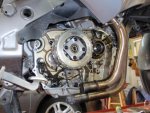Your explanation is partially correct. However, the winding does not go open or infinite ohms. The heat creates a condition called "Temperature Rise" and the resistance of winding raises. The coil is supposed to have a given impedance range, for discussion for purposes lets says it's supossed to be 300 to 440 ohms. If the coil resistance is at for this example 480 ohms after soaking in the heat the ECU will be not seeing the correct voltage threshold levels from the sensor and simply ignores them. Thus creating the "No Start" connection.
Here's some light reading for those interested in knowing more about coils and temperature rise. Estimating Temperature Rise of Transformers
The Crankshaft Positioning Sensor or Pulse Generator is basically a transformer generating a signal for the the ECU.
Your theory doesn't explain why a CKP will function properly for many, many miles and then suddenly fail. It has had numerous heat soaks throughout the course of its life, why doesn't it fail every time it gets hot? If you examine the output of the CKP with a scope when it has failed, you will not just see a weak signal, you will see no signal thus signifying an open circuit in the device.
Mike

